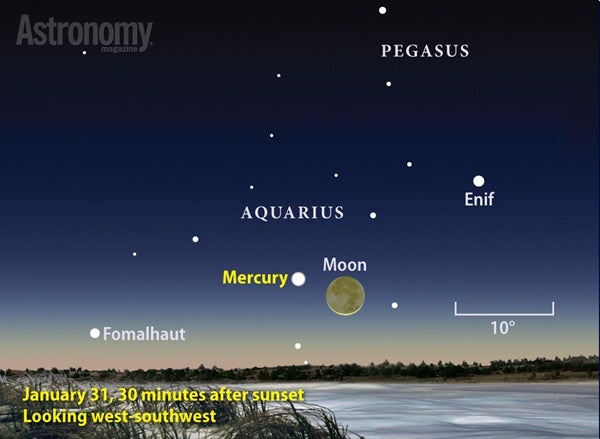Not all of these appearances are created equal, however. The driving factor in how high Mercury climbs is the orientation of the ecliptic — the apparent path of the Sun across our sky that the planets follow closely. When the ecliptic makes a steep angle to the horizon, as it does in the western sky after sunset for observers in the Northern Hemisphere in May, Mercury climbs quite high.
The inner planet reaches greatest elongation the night of May 6/7, when it lies 21° from the Sun. For observers at midnorthern latitudes, Mercury then appears 11° high in the west-northwest 45 minutes after sunrise. A week earlier, on April 30, it passes 2° south of the Pleiades star cluster (M45). The planet shines around magnitude 0 during this period, so it should show up with naked eyes. Try binoculars if you can’t find it right away in the twilight sky.
Unfortunately, Mercury’s appearance doesn’t last long. The planet fades as it falls back into brighter twilight. It glows at magnitude 1.0 on the 11th when it passes 8° north (to the upper right) of similarly bright Aldebaran, the constellation Taurus’ brightest star. Mercury disappears from view just a week later.
The planet’s best morning appearance comes in October, when Mercury climbs 8° high in the east 45 minutes before sunrise.
Fast facts:
- Mercury orbits the Sun at an average distance of 36 million miles (58 million kilometers) but covers a broad range from 29 million miles to 44 million miles (46 million km to 70 million km).
- Mercury takes just 88 days to complete one orbit of the Sun.
- Mercury takes 59 days to rotate once on its axis.
- With a diameter of 3,032 miles (4,879km, or 38 percent of Earth’s), Mercury is the smallest planet in the solar system.
- Video: Tour the Solar System: Mercury, with Liz Kruesi, contributing editor
- StarDome: Locate Mercury in your night sky with our interactive star chart.
- The Sky this Week: Get your planet observing info from a daily digest of celestial events coming soon to a sky near you.
- Sign up for our free weekly email newsletter.











